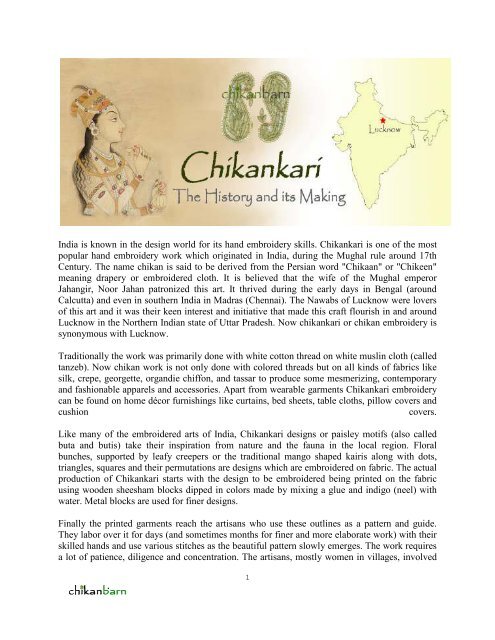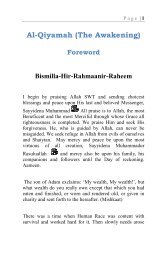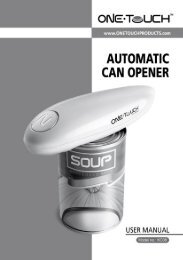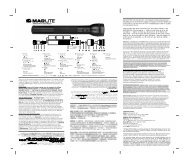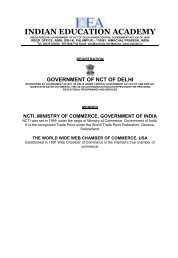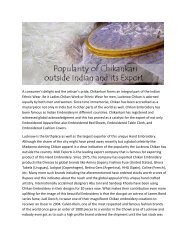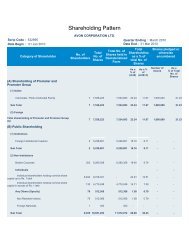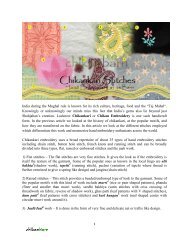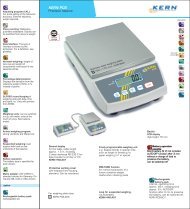Chikankari - The History and Its Making - Chikan Embroidery
Chikankari - The History and Its Making - Chikan Embroidery
Chikankari - The History and Its Making - Chikan Embroidery
Create successful ePaper yourself
Turn your PDF publications into a flip-book with our unique Google optimized e-Paper software.
India is known in the design world for its h<strong>and</strong> embroidery skills. <strong><strong>Chikan</strong>kari</strong> is one of the most<br />
popular h<strong>and</strong> embroidery work which originated in India, during the Mughal rule around 17th<br />
Century. <strong>The</strong> name chikan is said to be derived from the Persian word "Chikaan" or "Chikeen"<br />
meaning drapery or embroidered cloth. It is believed that the wife of the Mughal emperor<br />
Jahangir, Noor Jahan patronized this art. It thrived during the early days in Bengal (around<br />
Calcutta) <strong>and</strong> even in southern India in Madras (Chennai). <strong>The</strong> Nawabs of Lucknow were lovers<br />
of this art <strong>and</strong> it was their keen interest <strong>and</strong> initiative that made this craft flourish in <strong>and</strong> around<br />
Lucknow in the Northern Indian state of Uttar Pradesh. Now chikankari or chikan embroidery is<br />
synonymous with Lucknow.<br />
Traditionally the work was primarily done with white cotton thread on white muslin cloth (called<br />
tanzeb). Now chikan work is not only done with colored threads but on all kinds of fabrics like<br />
silk, crepe, georgette, org<strong>and</strong>ie chiffon, <strong>and</strong> tassar to produce some mesmerizing, contemporary<br />
<strong>and</strong> fashionable apparels <strong>and</strong> accessories. Apart from wearable garments <strong><strong>Chikan</strong>kari</strong> embroidery<br />
can be found on home décor furnishings like curtains, bed sheets, table cloths, pillow covers <strong>and</strong><br />
cushion covers.<br />
Like many of the embroidered arts of India, <strong><strong>Chikan</strong>kari</strong> designs or paisley motifs (also called<br />
buta <strong>and</strong> butis) take their inspiration from nature <strong>and</strong> the fauna in the local region. Floral<br />
bunches, supported by leafy creepers or the traditional mango shaped kairis along with dots,<br />
triangles, squares <strong>and</strong> their permutations are designs which are embroidered on fabric. <strong>The</strong> actual<br />
production of <strong><strong>Chikan</strong>kari</strong> starts with the design to be embroidered being printed on the fabric<br />
using wooden sheesham blocks dipped in colors made by mixing a glue <strong>and</strong> indigo (neel) with<br />
water. Metal blocks are used for finer designs.<br />
Finally the printed garments reach the artisans who use these outlines as a pattern <strong>and</strong> guide.<br />
<strong>The</strong>y labor over it for days (<strong>and</strong> sometimes months for finer <strong>and</strong> more elaborate work) with their<br />
skilled h<strong>and</strong>s <strong>and</strong> use various stitches as the beautiful pattern slowly emerges. <strong>The</strong> work requires<br />
a lot of patience, diligence <strong>and</strong> concentration. <strong>The</strong> artisans, mostly women in villages, involved<br />
1
in making these extraordinary, intricate <strong>and</strong> mesmerizing designs, form probably the largest<br />
artisan cluster in the world <strong>and</strong> this work is a source of livelihood for several families.<br />
Next, the clothes are h<strong>and</strong> washed <strong>and</strong> starch is applied (for a crisper fabric) <strong>and</strong> then ironed<br />
before the product is finally ready. Given the laborious process it takes for its creation, each<br />
chikankari garment is unique <strong>and</strong> a piece of art <strong>and</strong> consequently costs more than the mass<br />
produced machine embroidered apparels. In the next article on chikankari we look at the<br />
different types of stitches used in <strong>Chikan</strong> <strong>Embroidery</strong>.<br />
About the Author<br />
www.chikanbarn.com is an online store retailing select chikan work apparels, accessories <strong>and</strong><br />
home decor merch<strong>and</strong>ise. We are focused on brining this h<strong>and</strong> embroidery craft to the<br />
international market <strong>and</strong> making it easily accessible to people all over the globe. We endeavor to<br />
co-create a positive ecosystem for the overall benefit <strong>and</strong> growth of the industry <strong>and</strong> its<br />
participants (including the most important ones "the artisans"). Please do visit our store <strong>and</strong> also<br />
do help us reach out by giving us a like on our Facebook page<br />
http://www.facebook.com/chikanbarn<br />
2


